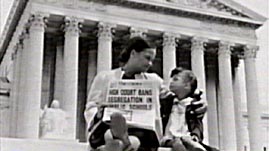In 1954, the Supreme Court ruled in
Brown v. Board of Education that segregated schools violated the Fourteenth Amendment and denied black students equal protection of the laws. However, the Court did not specify how the ruling would be implemented. This was the first time the federal government had intervened in public schools, an area traditionally overseen by state governments. While the Supreme Court had the power to interpret the law and declare segregation unconstitutional, the power to enforce the decision fell to state and local authorities.
In 1955, in what became known as
Brown II, the Supreme Court ruled that schools must act "with all deliberate speed." However, the ruling did not specify a timeframe. The NAACP saw the Court's ruling as ambiguous, and a setback. Many southern states refused to comply with the
Brown ruling, sparking tension between federal and state governments and creating an impasse for school desegregation.
Civil rights advocates wanted immediate integration, but segregationists were determined to prevent it. In 1956, 100 southern congressmen signed the Southern Manifesto, accusing the federal government of abusing judicial power and infringing on states' rights; they pledged not only to resist the ruling, but to reverse it. The only three southern senators who did not sign the Manifesto were Albert Gore Sr. (Tennessee), Estes Kefauver (Tennessee), and Lyndon B. Johnson (Texas).
In 1957, two years after
Brown II, the all-white school board in Little Rock, Arkansas became the first in the South to comply with the Court's ruling. But the school board's plan to desegregate the schools gradually over six years sparked massive resistance. Arkansas governor Orval Faubus ordered the National Guard to restore order and prevent nine black students from attending Central High School. When Faubus refused to guarantee the safety of the students, President Dwight D. Eisenhower, who was reluctant to get involved, finally enforced
Brown by sending federal troops to maintain order in Little Rock and escort the students into school. The troops stayed until the end of the school year.
The following year, rather than comply with the Court's ruling, Faubus closed the public schools. Similarly, other states continued to enforce local segregation laws and devised plans to resist integration. Public schools closed and private schools for white students, which were outside the jurisdiction of
Brown, were opened with state funding.
In 1959, the school board in Prince Edward County, Virginia defied a federal court order and closed its public schools to avoid integration. The schools remained closed for five years. In 1964, the Supreme Court ordered them reopened. By then, most white students attended private schools.
A decade after
Brown, despite some progress, the majority of black students in the South still attended black schools.

 Loading Standards
Loading Standards